 Heuglin's Gull (L. heuglini / antelius)
Heuglin's Gull (L. heuglini / antelius)
(last update:
Amir Ben Dov (Israel)
Chris Gibbins (Scotland)
Hannu Koskinen (Finland)
Mars Muusse (the Netherlands)
Probable adult heuglini near Zagreb
The 2012 international gull meeting (IGM) took place in February at Zagreb, Croatia. On Saturday 18 February several participants scanned a mixed flock of resting gulls at the parking lot near the landfill, when Albert Cama Torell noticed a Lesser Black-backed Gull Larus fuscus s.l. with slate-grey upperparts and active moult in the inner secondaries and P9-P10.
Description
 Head: adult winter, extensively mottled with finer streaks on the nape and crown, but more coarsely spotted in the neck and side of the breast.
Head: adult winter, extensively mottled with finer streaks on the nape and crown, but more coarsely spotted in the neck and side of the breast.
Upperparts: slate-grey, obvious darker than accompanying michahellis Yellow-legged Gulls and missing the bluish cast of the latter species. No dark markings on the greater primary coverts.
Rectrices: white.
Secondaries: all adult-like grey, with large white tips. S1-S14 fully grown, from S15 inwards a few feathers still growing, which are the last secondaries to be replaced in an ordinary complete moult sequence.
Primaries: adult-like grey with white tips. Black mark on outer-web of P4; complete sub-terminal band on P5; mirrors on P9 and on P10. P9 and P10 still growing. No obvious white ‘string of pearls’ on P6-P8.
Bare parts: not saturated, which is typical for winter plumage. Legs pale yellow; iris pale yellow lacking obvious speckling, orbital ring dark red; yellow bill with red gonydeal spot confined to lower mandible, some diffuse darker markings on bill.
During the four days of the IGM, seven individuals of the LBBG-complex were recorded near Zagreb, including one first winter bird, two second winters and four adults. Only one of these adults showed active moult; another one, with very fresh outer primaries was trapped and ringed and some feathers were taken for DNA analysis.
Identification of adult heuglini
Heuglin’s Gull Larus (fuscus) heuglini is a serious candidate as passage migrant in Croatia, but separation from adult intermedius and graellsii is known to be notoriously difficult. In the text below we mention ten characteristics and quantify these points for positive identification.
Structurally heuglini is more elegant with smaller head, slimmer, droopy bill and longer legs than western taxa (for measurements see table 1 in Gibbins, 2004, after Olssen, 2003). Measurements and bill dimensions vary between sexes and individual variation in absolute size and relative structure cause extensive overlap between taxa. General structure and jizz are also variable to mood and temper. The Zagreb bird was not particularly elegant and slender, it rather recalled British graellsii.
 The grey-tone of the upperparts strongly indicates this Croatian adult (and the other four adults present near Zagreb as well) to be graellsii, intermedius or heuglini. The grey-tone for heuglini is estimated Kodak 8-11 (Olssen 2003; Gibbins, 2004), or Kodak 8-13, which is slightly darker (Buzun, 2002). This nicely matches U.K. graellsii (Olssen, 2003) and the paler half of the spectrum in Dutch graellsii (Muusse et al, 2011). Darkest heuglini match pale SW Swedish intermedius, which have a population mean of 11.7 (Barth, 1975). LBBG are known to show large variation in grey-tone, even within a single colony, as illustrated by the range of Kodak 8-15 for 1038 Dutch birds at Moerdijk (population mean Kodak 11). Thus, heuglini overlaps with western taxa and does not have diagnostic upperpart grey-tone.
The grey-tone of the upperparts strongly indicates this Croatian adult (and the other four adults present near Zagreb as well) to be graellsii, intermedius or heuglini. The grey-tone for heuglini is estimated Kodak 8-11 (Olssen 2003; Gibbins, 2004), or Kodak 8-13, which is slightly darker (Buzun, 2002). This nicely matches U.K. graellsii (Olssen, 2003) and the paler half of the spectrum in Dutch graellsii (Muusse et al, 2011). Darkest heuglini match pale SW Swedish intermedius, which have a population mean of 11.7 (Barth, 1975). LBBG are known to show large variation in grey-tone, even within a single colony, as illustrated by the range of Kodak 8-15 for 1038 Dutch birds at Moerdijk (population mean Kodak 11). Thus, heuglini overlaps with western taxa and does not have diagnostic upperpart grey-tone.
 On average heuglini has more sub-terminal black in the wing, showing marks on six to eight primaries (Buzun, 2002). On this point, there is also complete overlap with Dutch graellsii, as 63% of Dutch breeding birds have seven primaries, 11% have eight primaries and 1% has nine primaries with black markings (>4cy n=1023; Muusse et al, 2011). The bird in active moult in Zagreb had seven primaries with sub-terminal black markings.
On average heuglini has more sub-terminal black in the wing, showing marks on six to eight primaries (Buzun, 2002). On this point, there is also complete overlap with Dutch graellsii, as 63% of Dutch breeding birds have seven primaries, 11% have eight primaries and 1% has nine primaries with black markings (>4cy n=1023; Muusse et al, 2011). The bird in active moult in Zagreb had seven primaries with sub-terminal black markings.
 Valery Buzun (2002) placed great emphasis on the wing-tip pattern in heuglini. His research was done for two regions: one population from the river Ob and another in Russian Zavorot. Buzun classified mirrors as "open" (mirror reaches the edge of the feather) and "closed" (black of the medial band runs down along the feather edge, enclosing the mirror). Most birds had open mirrors on P10, covering both webs. All except 3% from Russian Zavorot had a complete sub-terminal black band on P10. Most birds (about 75%) had no mirror on P9.
Valery Buzun (2002) placed great emphasis on the wing-tip pattern in heuglini. His research was done for two regions: one population from the river Ob and another in Russian Zavorot. Buzun classified mirrors as "open" (mirror reaches the edge of the feather) and "closed" (black of the medial band runs down along the feather edge, enclosing the mirror). Most birds had open mirrors on P10, covering both webs. All except 3% from Russian Zavorot had a complete sub-terminal black band on P10. Most birds (about 75%) had no mirror on P9.
For heuglini, the common wing-tip pattern would be: P9 without a mirror and P10 with open mirrors and a sub-terminal band. This is also a common pattern found throughout western LBBG, like Dutch graellsii and S Scandinavian intermedius (M. Helberg, pers. obs.). Moreover, heuglini showing limited white in the wing-tip with completely closed mirrors on P10 can also be found among breeding birds at Moerdijk.
About 43% of Dutch graellsii have the white mirror restricted to P10, hence no mirror on P9 and most (80%) have a complete sub-terminal band on P10 (Muusse et al, 2011). The Zagreb bird showed a small, closed mirror on the inner-web of P9, a closed mirtror on the inner-web of P10 and an open mirror on the outer-web of P10.
In heuglini the mirror on P10 is said to be further from the feather tip than it is in graellsii (Harris, 1996). The exact location of the P10 mirror in Dutch birds could not be measured due to wear in the primary tips when the breeding birds were trapped in May in the colony.
Buzun (2002) described the underwing pattern of P10 for heuglini to show a pure white base in most birds, so not contrasting with underwing coverts. Normally, Dutch birds have the base of the underside of P10 'grey', 'silvery' of 'pale greyish' coloured. Rough estimations would be: white base on the underside of P10 in Russia: 70-75%, for the Netherlands: 1-3%. However, strict classification of white or grey is debatable, as primary undersides show all kinds of shades in between, depending on light conditions and relative angle of observation (e.g. commonly found in Dutch birds are 'silvery grey' bases of the underwing of P10, but this is still not pure white.
Maybe best would be a direct comparison with the pure white greater primary coverts on the underwing, where they meet the base of P10. Scoring the P10 underside was not possible in the Zagreb bird, as P10 was in active moult and only half grown. Still, undersides of central primaries appeared to be obviously greyish in this bird, and one may assume the outer primaries to show approximately corresponding undersides, so at least not pure white.
Gibbins (2004) mentioned adult heuglini to have dark markings on primary coverts more frequently than graellsii, although he does not quantify this. Research on Dutch graellsii show most (75.5%) breeders to have some to extensive black on the primary coverts (n=962). Sixty-two birds showed primary coverts with extensive brown-black markings and diffuse borders; these were considered sub-adults, while 666 birds had limited, neatly demarcated black markings and were considered ‘mature adults’. In this group, 54 mature birds of known age (6cy-14cy) were scored, of which 41 (75.9%) showed neatly demarcated black pigmentation. There appeared to be no significant difference between the sexes and data from known-age birds (n=76) showed that the presence of black on the primary coverts is not significantly related to age (Muusse et al, 2011).
The adult bird at Zagreb did not show any black markings on the primary coverts.
Adult heuglini often has thin white crescents on the central primaries; crescents between the grey base and the black sub-terminal band, so the grey tongues are distinctly separated from the black on the inner-webs of P3-P8. A small sample of 42 Dutch breeding graellsii of known-age (>4cy) revealed that crescents are also present in about 23% of this population, although distinct pure white crescents on P7 and especially P8 must be very uncommon in the Netherlands.
Larger sample size and more accurate definitions of ´white crescents´ are needed to fully understand the presence of this feature. The adult in Zagreb showed a thin crescent on P5 and a weak hint of a crescent on P6, but none on P7 or P8.
Winter head streaking in adult heuglini may recall Larus cachinnans, as both may appear rather white-headed with streaking concentrated on the hindneck, like a ´boa´. In mid-winter, many have fine streaking on crown and nape, with coarsely dark spots and mottling on the hindneck and sides of the breast. The bird in active moult in Zagreb had ‘extensive streaking’, as is commonly found in British graellsii.
Heuglini, as well as nominate fuscus, are tundra-breeders on high latitudes and long-distance migrants to E Africa and the near-East. At the breeding grounds heuglini appears to be a late moulting species, and images from the wintering quarters support this. Buzun (2002) described primary moult commencement between 20 June and 20 July. By mid July, about 25% of breeding heuglini from the islands had moulted P3, while 30% of the tundra breeding heuglini had moulted P4 or even higher by mid July.
From the Moerdijk colony in the Netherlands we know 81% (n=997) of breeding graellsii are still not in complete moult by the last day of May. In 2003 we scored primary moult in 1114 ringed adult (>4cy) graellsii and intermedius in Belgium and the Netherlands. From this group, 378 ringed adults were scored in June and July, which allow direct comparison to Buzun’s birds. Data indicate western birds to be slightly behind in primary moult scores, when compared to heuglini.
Visa Rauste (1999) has scored 22 adult heuglini on primary moult in Archangelsk, NW Russia in early-September. His data can be compared to 100 western LBBG (81 graellsii and 19 intermedius) scored in the week 28 August - 4 September 2003. Despite the small sample sizes, data show a large range of moult scores by early September. Data also show that graellsii is slightly ahead of intermedius, (more retained old primaries in intermedius). On average, intermedius is ahead of heuglini, but there is also some overlap between all three taxa. Some heuglini in Rauste’s sample only just commenced the complete moult (P2-P10 still present).
It's not uncommon to find adult heuglini still moulting the outermost primaries in February in the near-East, while most graellsii and intermedius finish the complete moult by late December and early January. Hence, late moult may be a good indication for Heuglin's Gull, although Olssen (2003) give late dates for northern populations of intermedius as well: “Latest to finish moult are N breeders, which grow P9-P10 by February (early March), thus matching fuscus”. Helberg observed late moult in southern intermedius, when he photographed two birds in Western Sahara (23°41'35"N 015°57'57"W) still moulting P10 by February 2012. Both birds (4cy and 7cy birds in 2012) were ringed at Rauna, Farsund, Vest-Agder, Norway (58°03'33"N 006°40'10"E). These two were the only ringed birds moulting outer primaries, but more (unringed) birds did so as well and Helberg estimates 2%-6% of the birds present at Dakhla in February to be in the last phase of the complete moult.
Sound.
DNA analysis.
Luka Jurinovic, Albert Cama Torell, Morten Helberg, Ruud Altenburg, Chris Gibbins, Mars Muusse
References:
Buzun V.A., 2002. Descriptive update on gull taxanomy: 'West Siberian Gull'. British Birds 2002/95.
Rauste V., 1999. Kennzeichenund Mauser von "Baltischen Herringsmowen" Larus [fuscus] fuscus und "Tundramowen" L. [fuscus] heuglini - Teil I. Limicola 1999/13 Heft 3.
Stresemann E. & Stresemann V., 1966. Die mauser der Vogel. J. Ornithol. 107 (Sonderh.).
Possible heuglini at IGM Zagreb 2012.
 possible heuglini adult, February 19 2012, Zagreb landfill, Croatia. Most attention went to this adult with active moult in the inner secondaries and P9-P10; an indication for heuglini. Originally found on Saterday 18 February 2012, by Albert Cama Torell, at the parking lot next to the dump. Again on Sunday, now feeding on the dump.
We had 7 birds of the LBBG-complex during the IGM.
possible heuglini adult, February 19 2012, Zagreb landfill, Croatia. Most attention went to this adult with active moult in the inner secondaries and P9-P10; an indication for heuglini. Originally found on Saterday 18 February 2012, by Albert Cama Torell, at the parking lot next to the dump. Again on Sunday, now feeding on the dump.
We had 7 birds of the LBBG-complex during the IGM.  possible heuglini adult, February 19 2012, Zagreb landfill, Croatia. Another adult, with mirrors on both P9 and P10 and no black on P4.
possible heuglini adult, February 19 2012, Zagreb landfill, Croatia. Another adult, with mirrors on both P9 and P10 and no black on P4.  possible heuglini 2cy, February 19 2012, Zagreb landfill, Croatia. 2cy bird, still most in complete juvenile plumage, except for some scapulars which have been replaced for 2nd gen feathers.
possible heuglini 2cy, February 19 2012, Zagreb landfill, Croatia. 2cy bird, still most in complete juvenile plumage, except for some scapulars which have been replaced for 2nd gen feathers.  possible heuglini adult, February 19 2012, Zagreb landfill, Croatia. Here is another: the 'Lesser Black-backed Gull' caught with cannon netting, compared to michahellis.
Vermillion orbital ring. Extensive head streaking. Black on P4-P10. No mirror on P9. In Buzun's terminology, these P10 spots (he uses "2 mirrors") would be called 'closed' (not reaching the feather's edge).
possible heuglini adult, February 19 2012, Zagreb landfill, Croatia. Here is another: the 'Lesser Black-backed Gull' caught with cannon netting, compared to michahellis.
Vermillion orbital ring. Extensive head streaking. Black on P4-P10. No mirror on P9. In Buzun's terminology, these P10 spots (he uses "2 mirrors") would be called 'closed' (not reaching the feather's edge).  possible heuglini adult, February 18 2012, Zagreb landfill, Croatia. Pictures: Chris Gibbins & Ruud Altenburg. Here is another: an adult with snowy white head.
possible heuglini adult, February 18 2012, Zagreb landfill, Croatia. Pictures: Chris Gibbins & Ruud Altenburg. Here is another: an adult with snowy white head. Differences in structure between graellsii, intermedius & heuglini.
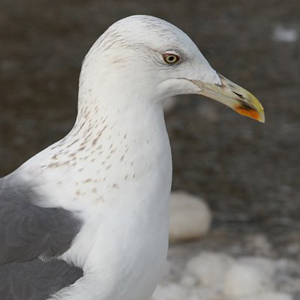 Heuglini adult, February 09 2009, United Arab Emirates. Picture: Chris Gibbins. Elegant structure of heuglini may be found in western taxa as well.
Heuglini adult, February 09 2009, United Arab Emirates. Picture: Chris Gibbins. Elegant structure of heuglini may be found in western taxa as well.
Upperpart grey-tone in LBBG.
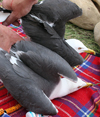 Graellsii & intermedius upperpart grey-tone compared to heuglini.
Graellsii & intermedius upperpart grey-tone compared to heuglini.Number of primaries with black sub-terminal pigmentation.
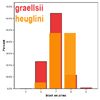 Graellsii & heuglini number of primaries with black sub-terminal pigmentation. This graph illustrates the overlap in number of primaries showing black markings. Only on average there is more black in heuglini.
Graellsii & heuglini number of primaries with black sub-terminal pigmentation. This graph illustrates the overlap in number of primaries showing black markings. Only on average there is more black in heuglini.Primary patterns on P9 and P10.
 Heuglini distribution and classification for P10 and P9 used by Valery Buzun. His research was done for the river Ob and Russian Zavorot. Valery is more specific in the exact pattern of the mirrors on P9 and P10, as he classifies mirrors as "open" (mirror reaches the edge of the feather) and "closed" (black of the medial band runs down along the feather edge, enclosing the mirror. Another important point to remember: he defined "mirror" as a white spot on the feather's web. Hence, P10 normally shows 2 mirrors: one on the inner and one on the outer-web. He only found birds with broken sub-terminal black bands on P10 at the Russian Zavorot, all other had complete sub-terminal bands.
Heuglini distribution and classification for P10 and P9 used by Valery Buzun. His research was done for the river Ob and Russian Zavorot. Valery is more specific in the exact pattern of the mirrors on P9 and P10, as he classifies mirrors as "open" (mirror reaches the edge of the feather) and "closed" (black of the medial band runs down along the feather edge, enclosing the mirror. Another important point to remember: he defined "mirror" as a white spot on the feather's web. Hence, P10 normally shows 2 mirrors: one on the inner and one on the outer-web. He only found birds with broken sub-terminal black bands on P10 at the Russian Zavorot, all other had complete sub-terminal bands. P9 - P10 patterns in western LBBG: no mirror on P9, closed mirror on P10.
 Intermedius adult J0Y1 May 23 2009, Lyngøy, Hordaland, Norway. Picture: Morten Helberg. Vermillion orbital ring. Black on P4-P10. No mirror on P9. In Buzun's terminology, these P10 spots (he uses "2 mirrors") would be called 'open' (mirrors on p10 reaching the feather's edges).
Intermedius adult J0Y1 May 23 2009, Lyngøy, Hordaland, Norway. Picture: Morten Helberg. Vermillion orbital ring. Black on P4-P10. No mirror on P9. In Buzun's terminology, these P10 spots (he uses "2 mirrors") would be called 'open' (mirrors on p10 reaching the feather's edges).  Graellsii sub-adult 5E 08 May 2006, Moerdijk, the Netherland. Mirror on P10 does not reach the edge on the inner-web. Black on P4-P10. No mirror on P9. Impossible to quantify detailed patterns of mirrors in Dutch birds, in analogy of what Buzun has done for heuglini, as it is difficult to score the outer-web shape of the mirror, due to extensive wear by May.
Graellsii sub-adult 5E 08 May 2006, Moerdijk, the Netherland. Mirror on P10 does not reach the edge on the inner-web. Black on P4-P10. No mirror on P9. Impossible to quantify detailed patterns of mirrors in Dutch birds, in analogy of what Buzun has done for heuglini, as it is difficult to score the outer-web shape of the mirror, due to extensive wear by May.P9 - P10 patterns in western LBBG: large mirror on P9, broken sub-terminal band on P10.
 Intermedius adult J0Y3 May 23 2009, Lyngøy, Hordaland, Norway. Picture: Morten Helberg. Vermillion orbital ring. Black on P5-P10. Large mirrors on P9 and P10. Sub-terminal black on P10 strongly reduced to spot near the shaft.
Intermedius adult J0Y3 May 23 2009, Lyngøy, Hordaland, Norway. Picture: Morten Helberg. Vermillion orbital ring. Black on P5-P10. Large mirrors on P9 and P10. Sub-terminal black on P10 strongly reduced to spot near the shaft. Intermedius adult J0Y6 May 23 2009, Lyngøy, Hordaland, Norway. Picture: Morten Helberg. Vermillion orbital ring. Black on P5-P10. Large mirrors on P9 and P10. Broken sub-terminal band on P10 strongly reduced to spots near the shaft and near feather's edge.
Intermedius adult J0Y6 May 23 2009, Lyngøy, Hordaland, Norway. Picture: Morten Helberg. Vermillion orbital ring. Black on P5-P10. Large mirrors on P9 and P10. Broken sub-terminal band on P10 strongly reduced to spots near the shaft and near feather's edge. Intermedius adult J1Y2 May 30 2010, Lyngøy, Hordaland, Norway. Picture: Morten Helberg. Vermillion orbital ring. Black on P5-P10. Mirrors on P9 and P10. Broken sub-terminal band on P10 strongly reduced to spots near the feather's edge.
Intermedius adult J1Y2 May 30 2010, Lyngøy, Hordaland, Norway. Picture: Morten Helberg. Vermillion orbital ring. Black on P5-P10. Mirrors on P9 and P10. Broken sub-terminal band on P10 strongly reduced to spots near the feather's edge.Underwing pattern of P10.
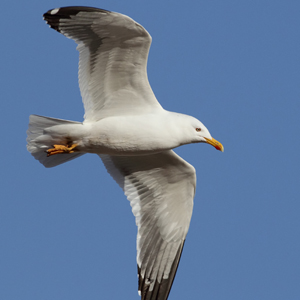 Heuglini adult, March 2010, Ashdod, Israel. Picture: Amir Ben Dov. Scored "white base on underside of P10". Page to compare heuglini with graellsii, regarding contrast between underwing primary coverts and base of the underside of P10.
Heuglini adult, March 2010, Ashdod, Israel. Picture: Amir Ben Dov. Scored "white base on underside of P10". Page to compare heuglini with graellsii, regarding contrast between underwing primary coverts and base of the underside of P10.
Dark markings on primary coverts.
 Heuglini adult, February 02-09 2009, United Arab Emirates. Picture: Chris Gibbins. Bird at the fish-market. Note black on primary coverts.
Heuglini adult, February 02-09 2009, United Arab Emirates. Picture: Chris Gibbins. Bird at the fish-market. Note black on primary coverts.
White crescents on central primaries.

Winter head streaking.

Late moulting intermedius in February.
 Intermedius 6cy J13N February 07 2012, Dakhla 2, Western Sahara (23°41'35"N 015°57'57"W). Pictures: Morten Helberg. Dark red orbital ring. Extensive head streaking and much black on the bill. P9 fully grown, P10 still growing by February. Ringed on July 14 2007 at Rauna, Farsund, Vest-Agder, Norway (58°03'33"N 006°40'10"E), by Knut Sigbjørn Olsen.
Intermedius 6cy J13N February 07 2012, Dakhla 2, Western Sahara (23°41'35"N 015°57'57"W). Pictures: Morten Helberg. Dark red orbital ring. Extensive head streaking and much black on the bill. P9 fully grown, P10 still growing by February. Ringed on July 14 2007 at Rauna, Farsund, Vest-Agder, Norway (58°03'33"N 006°40'10"E), by Knut Sigbjørn Olsen. Intermedius 4cy JXJ4 February 09 2012, Layonne rubbish tip, Western Sahara (27°04'18"N 013°23'31"W). Pictures: Morten Helberg. Black on P4-P10. Extensive head streaking and much black on the bill. P9 fully grown, P10 still growing by February. Note missing inner secondaries, at classic location when the complete moult is to be finished soon. Ringed on July 12 2009 at Rauna, Farsund, Vest-Agder, Norway (58°03'33"N 006°40'10"E), by Marton Berntsen.
Intermedius 4cy JXJ4 February 09 2012, Layonne rubbish tip, Western Sahara (27°04'18"N 013°23'31"W). Pictures: Morten Helberg. Black on P4-P10. Extensive head streaking and much black on the bill. P9 fully grown, P10 still growing by February. Note missing inner secondaries, at classic location when the complete moult is to be finished soon. Ringed on July 12 2009 at Rauna, Farsund, Vest-Agder, Norway (58°03'33"N 006°40'10"E), by Marton Berntsen.Sound.
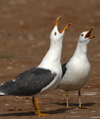 Olsen & Larsson describe the voice of heuglini: "Deeper and stronger than Herring and Lesser Black-backed Gull: a nasal gagaga (Lindholm 1997)". On this page you find some MP3 recordings for graellsii, intermedius and heuglini.
Olsen & Larsson describe the voice of heuglini: "Deeper and stronger than Herring and Lesser Black-backed Gull: a nasal gagaga (Lindholm 1997)". On this page you find some MP3 recordings for graellsii, intermedius and heuglini.